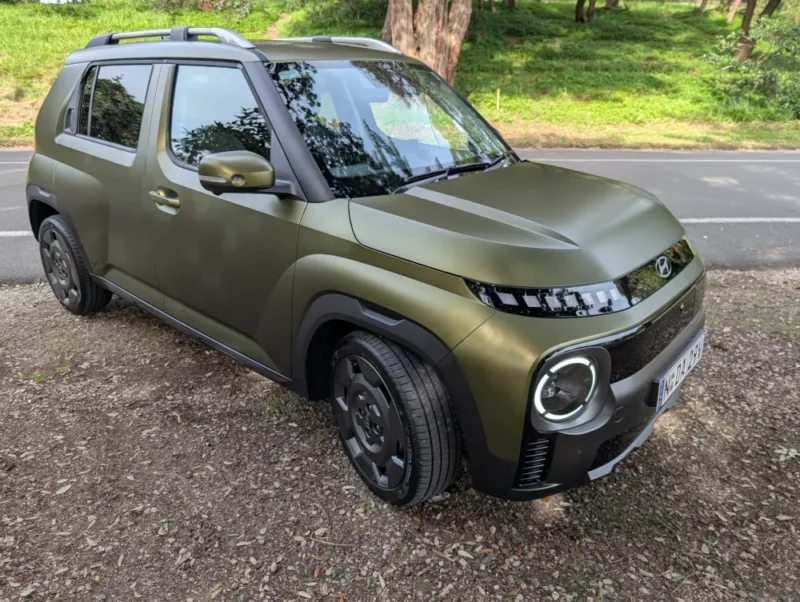Hyundai recently launched the Inster, their smallest and most affordable electric vehicle in Australia. The Driven was invited to a media event in Sydney this week, where we got the opportunity to test drive the Inster range and experience first hand just how much Hyundai managed to squeeze into this tiny package.
I had been looking forward to testing out the Inster since first hearing about it, and watching the famously tall Jack from Fully Charged Show slide easily into the back seat behind his own driving position. Seeing the Inster in person did not disappoint, the interior space and practicality in a car this size is truly mind blowing.
The Inster lineup starts with a Standard Range variant for $39,000 plus on-road costs, equipped with a 42 kWh battery offering up to 327 km of WLTP range. The Inster Extended Range starts from $42,500 with a slightly larger 49 kWh battery and 360 km range.
At the top of the trio sits the Inster Cross starting from $45,000, utilising the same 49 kWh extended range battery pack. Driving range for the Cross depends on whether you select the sunroof option (360 km) or roof basket which drops the figure down to 293 km, although you can remove the roof basket to conserve range when you’re not using it.
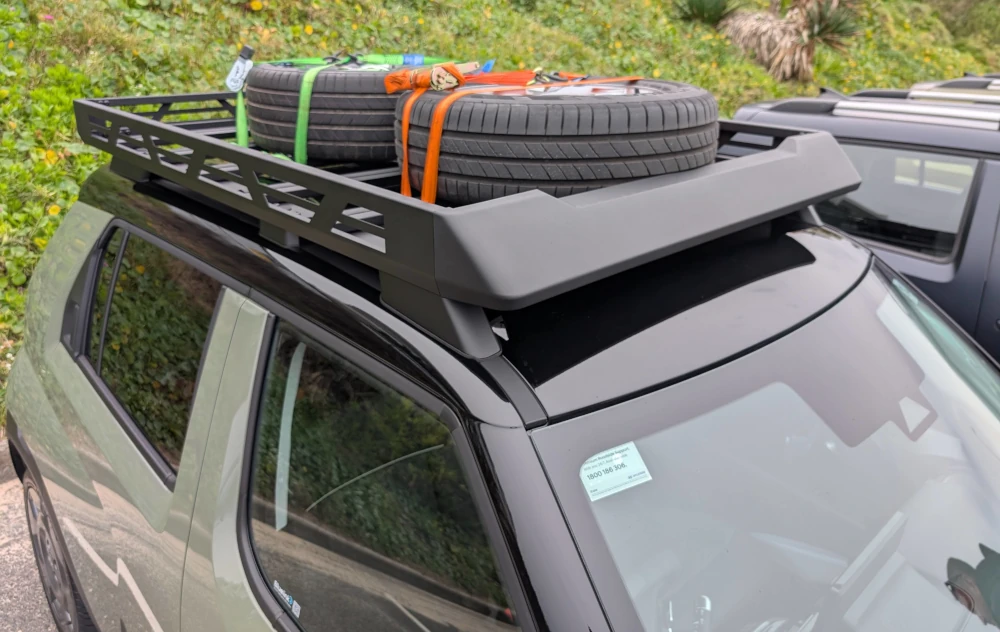
Inster Cross variants also come with exclusive bumpers, skid plates and side skirts for a more rugged look. The Inster is immediately recognisable as one of Hyundai’s EVs, featuring their signature pixel light design on the front indicators and rear brake lights.
Inster is already available to test drive and buy at dealerships, Hyundai confirmed around 600 vehicles have landed in the country so far. A handful of early customers have also taken delivery of an Inster, with 51 sales recorded in the April 2025 data.
Compact exterior hides surprisingly practical storage
Measuring just 3.8 m long and 1.6 m wide, Inster is not only Hyundai’s smallest EV, it is one of the smallest EVs currently available in Australia. Only a Fiat/Abarth 500e is shorter at just 3.6 m long and 1.68 m wide, but interior space and practicality in the 500e is severely limited compared to the Inster.
The Mini Cooper electric is also 3.8 m long, but is slightly wider than the Inster, measuring 1.75 m across. Neither the 500e or Mini Cooper with 2-doors are as practical as the Inster though, with its 4-doors providing easy access to the rear seats.
Other EVs that people regard as being small are actually 40 or 50 cm longer than an Inster and 15 to 20 cm wider. For example, the MG4 (4.3 m long x 1.8 m wide), BYD Dolphin (4.3 m x 1.77 m), GWM Ora (4.2 m x 1.8 m) and Kia EV3 (4.3 m x 1.85 m).
Boot space in the Inster varies depending on the rear seating position, as the rear seats are split 50:50 and can independently slide and fold. With the rear seats positioned all the way back for maximum passenger space, minimum boot space is 280 L measured using the VDA standard, including a deep section found underneath the boot floor.
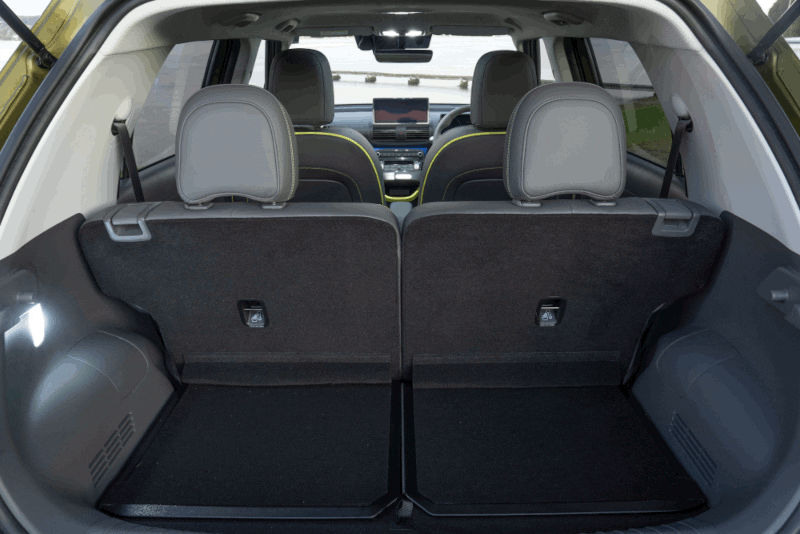
Sliding the rear seats forwards opens up 351 L of boot space, while folding both rear seats flat yields 1,059 L. Front seats in the Inster Cross variant can also fold flat in a 50:50 split configuration, allowing longer items to be stowed down the passenger side while still carrying 2 passengers in tandem.
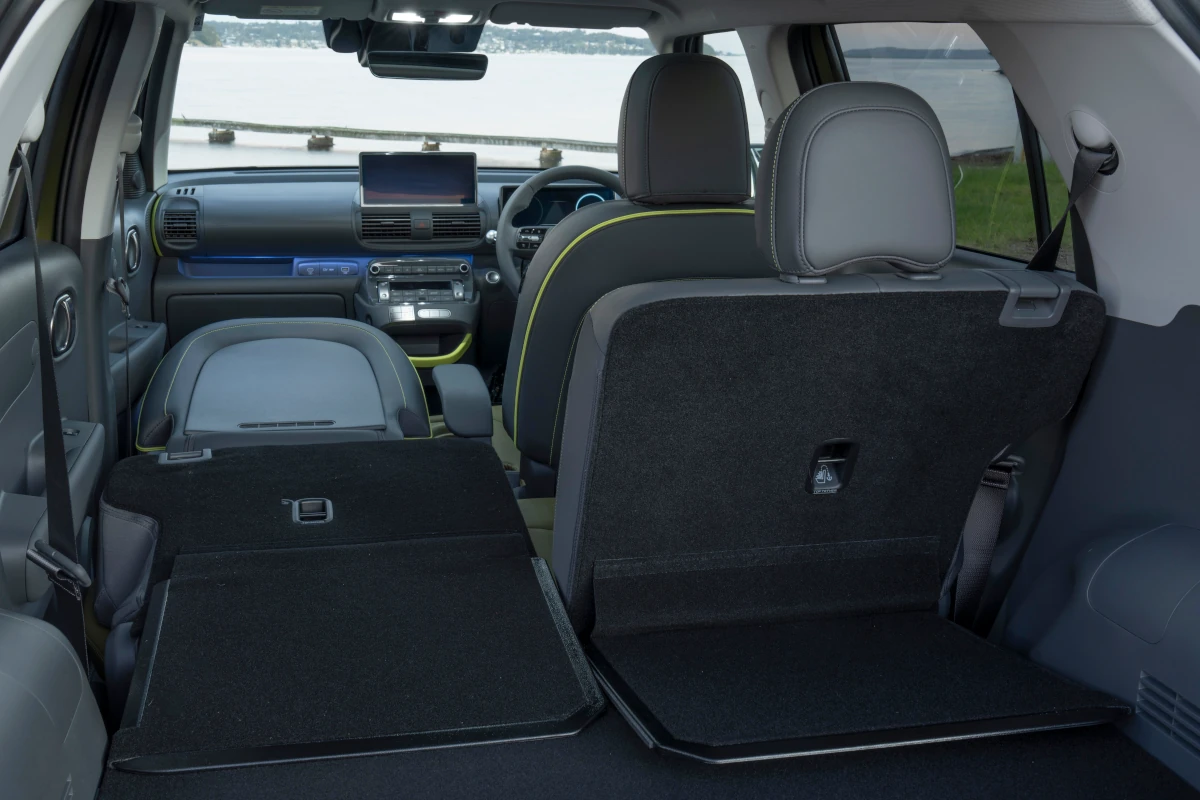
Tardis-like interior and full-featured infotainment
Looking at the numbers first, Hyundai presented a comparison of the interior dimensions for the Inster compared to a Hyundai Kona EV, which clearly demonstrates how much space they have managed to create inside the vehicle.
| Interior Dimension (mm) | Hyundai Inster | Hyundai Kona EV | |
| Headroom | Front Rear |
1,028 982 |
1,015 972 |
| Legroom | Front Rear |
1,050 885 – 958 |
1,059 925 |
| Shoulder room | Front Rear |
1,290 1,260 |
1,435 1,402 |
The Kona EV is a much bigger car, but the Inster still offers slightly more headroom in the front and rear, similar legroom in the front and potentially more in the rear with the seat slid back. Shoulder room is narrower in the Inster, but this is expected given the Kona is 20 cm wider.
The narrow width means you do sit fairly close together in the front seats and have to share a single armrest, but the lack of a centre console between the seats makes it feel more spacious than the numbers illustrate. It’s also a positive if you or your partner like to rest a hand on each other’s leg, or you need to slide across to get out of the opposite door.
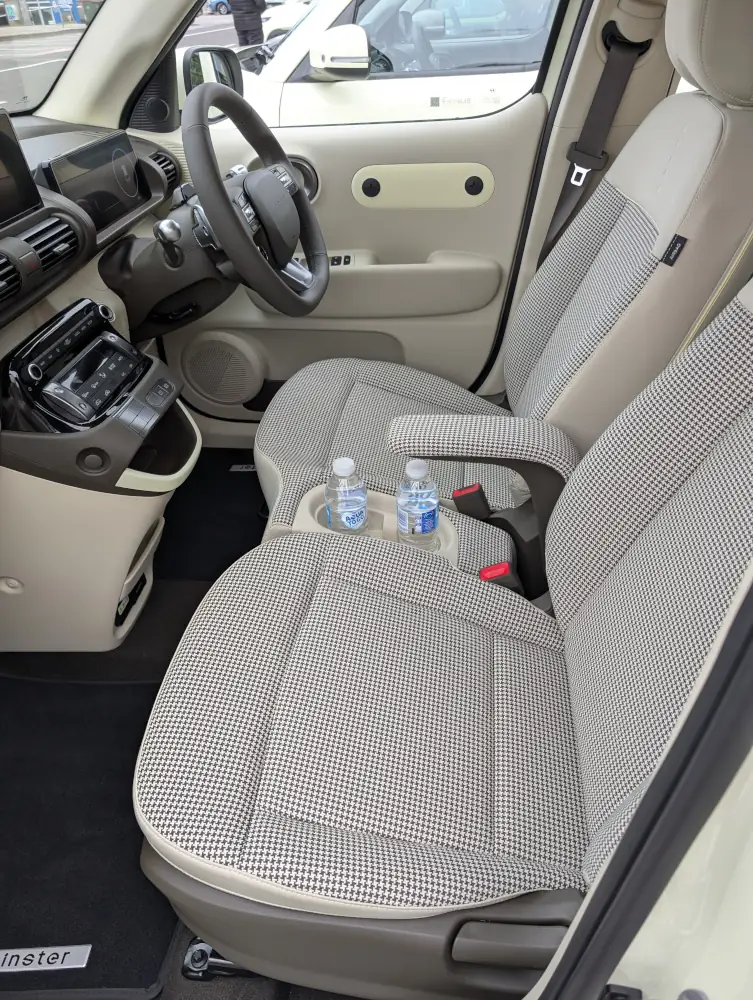
Front seats and steering wheel are all manually adjustable, with plenty of movement available to get into a good driving position. I found the seats were comfortable including a 1.5 hour long trip, although armrests on the door lack padding so these may become uncomfortable to rest your elbow during longer drives.
I was disappointed to learn that the front seats only fold fully flat on the Inster Cross, as it is a cool feature I was looking forward to. They tilt forwards on other variants, but nowhere near flat enough to carry long items down the passenger side or potentially camp in with a mattress, so keep that in mind if you are the adventurous type.
Rear seats are split 50:50 and can independently slide, fold and recline to optimise for passenger comfort or storage space. I am 175 cm tall and had oodles of legroom sitting behind my own driving position with the rear seats slid back. Don’t take my word for it either, see Jack from Fully Charged Show who is almost 2 m tall do the same thing easily.
With the rear seat slid all the way forwards I could still sit comfortably too, with my knees just touching the front seat. For shorter trips with luggage in the boot the Inster could easily accommodate 4 adults without a problem, something that’s not possible in other EVs this size.
Hyundai has cleverly maximised interior storage space too, including handy trays for smaller items in the front dash and centre console, 2 cup holders between the front seats and a small glovebox. Door pockets are quite narrow, so they don’t fit water bottles and rear seat passengers miss out on map pockets and cup holders.
Infotainment is handled by dual 10.25 inch screens, a digital instrument cluster and centrally located touchscreen that is crisp and easy to use. Icons and navigation will feel familiar if you have driven other Hyundai or Kia electric vehicles.
Below the central touchscreen is a row of buttons with shortcuts for map, navigation, settings and so on, which are handy when you want to quickly go directly from adjusting something back to the map.
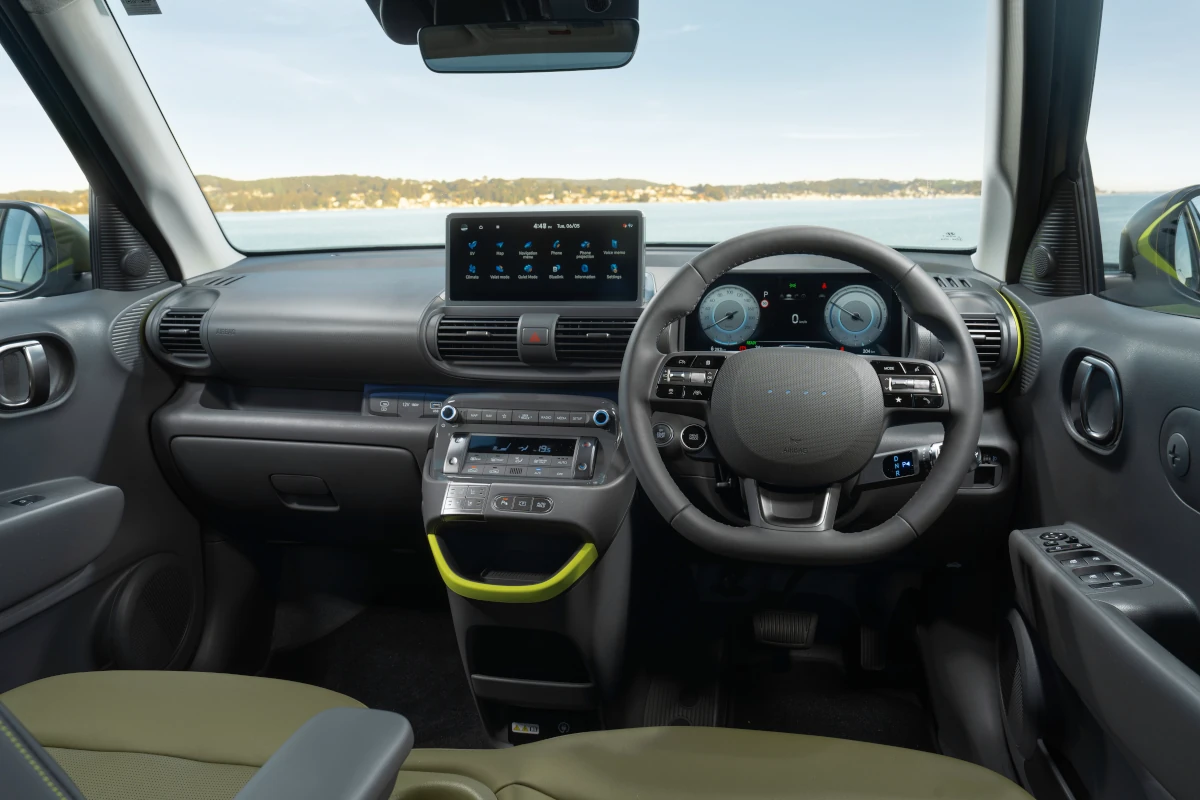
Another cluster of buttons in the centre console gives direct access for adjusting climate control. Buttons may not be to everyone’s taste, but they do free up the touchscreen and make it easy to control temperature, fan speed and direction of air flow quickly.
The Inster comes fully equipped with Hyundai Bluelink connected car service and built-in navigation across the range. Apple CarPlay and Android Auto are also supported via a wired connection if you prefer to use your own phone apps.
Powering devices on the go is easy, there is USB-C, USB-A and a 180 W 12 V outlet on the front dash, plus a wireless charging pad with cooling function in the centre console. The interior V2L socket is located near the floor between the front seats and outputs up to 16 A or 3.6 kW.
Smooth and efficient driving
Driving the Inster is another area where its compact size quickly becomes a feature that makes it stand out from the crowd. Weighing just 1,300 – 1,400 kg depending on variant, the Inster feels zippy and fun to drive as well as simple to park anywhere.
Inster may not be the quickest or sportiest EV out there, but it impressed me overall with smooth power delivery, good grip, accurate handling and suspension that rides over bumps and potholes well. Acceleration up to 70 or 80 km/h is brisk, where this car will spend most of its time, while adequate for highway speeds it can start to run out of puff into triple digits.
Regenerative braking is adjustable via steering wheel paddles, from off to i-Pedal which gives you the full one pedal driving experience. Unlike newer versions of i-Pedal which works in reverse and sticks between drives, it must be enabled every time you start the Inster or change gears.
Noise levels inside the cabin are better than expected for a compact car, due to Hyundai taking extra care with NVH through reinforced floor members, double-sealing door systems and a full underbody cover to reduce road noise. Extensive testing was also conducted in the outback to ensure the car could handle Australian conditions.

When it comes to driver assistance, most features are standard across all Inster variants including adaptive cruise control with lane centering, blind spot monitoring system, speed limit information, lane keeping and collision avoidance. I found the adaptive cruise and lane centering system worked well, with only occasional meandering in the lane.
Some additional convenience features like the blind spot view camera that appears in the instrument cluster when indicating, and the 360-degree camera are reserved for the Inster Cross. However, visibility is excellent in all directions and it is easy to park anyway, so these features are not necessary like they might be on much larger cars.
Similar to other Hyundai and Kia vehicles, the speed limit warning and driver attention warning can sometimes give false positives, so programming one of the star shortcut buttons to the driver assistance settings is a good idea as it resets each time you start the car.
As expected for such a small and relatively light electric vehicle, efficiency is a strong point for the Inster, it even beat the advertised figures during our test drive loop. Hyundai advertises 15.1 kWh/100 km for the Extended Range with sunroof, although we observed 11.6 kWh/100 km on the first 50 km leg.
In a Standard Range I consumed just 11.0 kWh/100 km travelling 66 km between Austinmer and Zetland, including 110 km/h sections on the M1/A1 highway. The right hand side of the instrument cluster displays the estimated range along with minimum and maximum range values which is a nice feature starting to appear in more EVs.

With this level of efficiency, the WLTP range ratings should be easily achievable and potentially beatable with primarily city driving. Perhaps even getting close to 400 km in a Standard Range Inster or over 400 km in an Extended Range without the roof basket.
Charging and ownership
The charge port on the Inster is located on the front bumper, with a manually operated door. This location should make it easy to charge from any public charging station without needing to stretch or drape heavy cables over the paintwork.
Maximum charging speeds for the Inster are up to 10.5 kW AC via a 3-phase connection and 120 kW DC. Expected charge times using various connection types are shown in the table of specifications below. A trickle charge cable for plugging into a standard 10 A outlet is included with the car too.
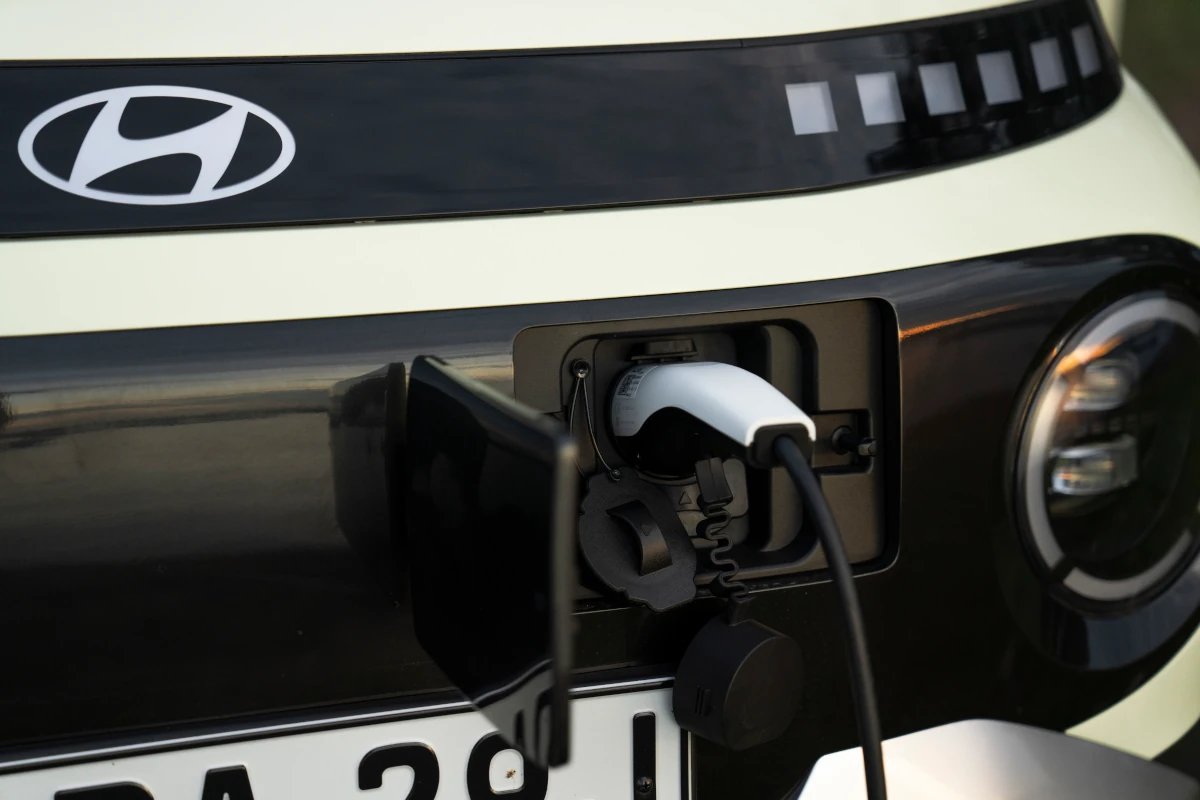
The Inster comes with vehicle to load (V2L) capability that matches other Hyundai EVs, capable of outputting up to 16 A or 3.6 kW via the internal socket between the front seats or an external V2L adapter. The external adapter does not come standard with any Inster, Hyundai will sell you one for $624.76 on their website.
EV trip planning and public charging information are provided by the built-in navigation system, or alternatively through your smartphone if using the wired Apple CarPlay or Android Auto connection.
In terms of servicing and warranty, Hyundai includes a 5-year unlimited km warranty with 8 years or 160,000 km on the high-voltage battery. Service intervals are every 2 years or 30,000 km. Pre-paid servicing is available at a cost of $655 for 2 years, or $1,310 for 4 years and 2 services.
Conclusion
I had high expectations leading up to the Inster launch and my only disappointment, apart from the front folding seats not being standard across the range, was hearing that Hyundai doesn’t think it will be a volume seller, because I’d love to see tons of these on the road instead of more giant utes and SUVs.
Even though I only spent several hours with the Inster over a 2 day launch event, I came away impressed with Hyundai’s newest EV.
The Inster is a fun and easy car to drive that packs in a lot of standard features for the price, from V2L, feature-rich infotainment and connected car services, adaptive cruise with lane centering, and a heat pump air-conditioning system that helps to keep energy consumption down.
Last but certainly not least is the compact exterior size that does not hinder practicality or interior space at all. The Inster’s size is undoubtedly its best feature, allowing you to navigate city streets and tight parking spaces with ease, or simply enjoy driving this zippy little car around.
Table of key specifications for the Hyundai Inster
| Variant | Inster Standard Range | Inster Extended Range | Inster Cross | ||
| Starting price, plus on-road costs | $39,000 | $42,500 | $45,000 | ||
| Paint colours | 9 colours in total, choice depends on variant:
|
||||
| Battery size | 42 kWh gross, 40 kWh usable | 49 kWh gross, 46 kWh usable | |||
| Battery chemistry | Nickel Manganese Cobalt (NMC) | ||||
| Range (WLTP) | 327 km | 360 km | 360 km (Sunroof) 293 km (Roof Basket) |
||
| Driven wheels | Front-wheel drive | ||||
| Power / Torque | 71 kW / 147 Nm | 84 kW / 147 Nm | |||
| Maximum charging speed | 10.5 kW AC, 120 kW DC | ||||
| Charging time (AC, 10 – 100%) | 10.5 kW AC – 4 hours 2.3 kW AC – 17 hours 45 minutes |
10.5 kW AC – 4 hours 35 minutes 2.3 kW AC – 20 hours 40 minutes |
|||
| Charging time (DC, 10 – 80%) | 50 kW DC – 58 minutes 120 kW DC – 30 minutes |
||||
| Bidirectional charging | Yes: V2L only, 3.6 kW output via internal socket or V2L adapter | ||||
| Exterior dimensions | Length: 3,825 mm (Cross 3,845 mm) Width: 1,610 mm Height: 1,610 mm Wheelbase: 2,580 mm Ground clearance: 144 mm |
||||
| Kerb mass | 1,305 kg | 1,335 kg | 1,410 kg (Roof Basket) | ||
| Storage space | Frunk: N/A Boot, rear seats up: 280 – 351 L Boot rear seats folded: 1,059 L |
||||
| Service interval | 24 months / 30,000 km | ||||

Tim has 20 years experience in the IT industry including 14 years as a network engineer and site reliability engineer at Google Australia. He is an EV and renewable energy enthusiast who is most passionate about helping people understand and adopt these technologies.


